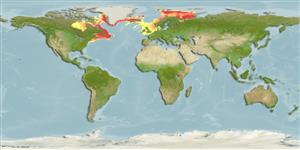Classification / Names
Common names from other countries
Main reference
Size / Weight / Age
Max length : 105 cm TL male/unsexed; (Ref. 53748); max. published weight: 11.4 kg (Ref. 53748); max. reported age: 28 years (Ref. 88929)
Length at first maturity
Lm 87.5 range ? - ? cm
Environment
Marine; brackish; demersal; oceanodromous (Ref. 51243); depth range 20 - 1000 m (Ref. 4426), usually 50 - 100 m (Ref. 4426)
Climate / Range
Temperate; -1°C - 14°C (Ref. 49751), preferred ?; 72°N - 33°N, 78°W - 41°E (Ref. 55275)
Distribution
Eastern Atlantic: Svalbard, Greenland and Iceland to the English Channel, including the North Sea (except southern part) and the western part of the Baltic; also off Cape Town, South Africa (Ref. 5578). Western Atlantic: Greenland and Hudson Bay, Canada to South Carolina, USA (Ref. 7251).
Countries | FAO areas | Ecosystems | Occurrences | Introductions
Short description
Dorsal
spines
(total): 0;
Anal
spines: 0;
Anal
soft rays: 0. Adults are rhomboid in shape, young are rounder (Ref. 7251). Short, stiff, bluntly triangular snout; tail shorter than body (Ref. 5578). Upper surface very rough, with solid thornlets scattered all over disc and tail, underside smooth, except for some prickles on snout; a constant pattern of separate orbital thorns, a regular row of 13-17 large thorns from nape to first dorsal fin (Ref. 3167); large, close-set thorns with star-shaped bases at upper disc (Ref. 5578). Coloration highly variable; brownish grey with scattered irregular black blotches dorsally; white ventrally; with darker spots and blotches on tail and pelvic fins; black spot on tip of tail (Ref. 2708).
IUCN Red List Status (Ref. 115185)
Threat to humans
Harmless
Human uses
Fisheries: minor commercial; gamefish: yes
More information
ReferencesAquacultureAquaculture profileStrainsGeneticsAllele frequenciesHeritabilityDiseasesProcessingMass conversion
Tools
Special reports
Download XML
Internet sources
Estimates of some properties based on models
Phylogenetic diversity index
PD50 = 0.5010 many relatives (e.g. carps) 0.5 - 2.0 few relatives (e.g. lungfishes)
Trophic Level
4.2 ±0.3 se; Based on diet studies.
Resilience
Low, minimum population doubling time 4.5 - 14 years (K=0.17; tm=4; Fec=13-20)
Vulnerability
High vulnerability (59 of 100)
Price category
